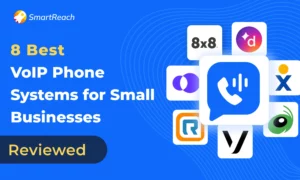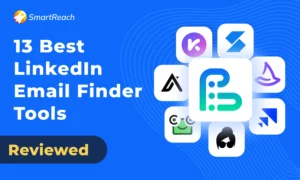13 Strategies to Increase B2B Sales in Today’s Competitive Market
Image source: Freepik
Many companies today face the challenge of increasing their sales and staying ahead of their competitors. It’s not easy to stand out and attract new customers.
However, by adopting effective strategies, businesses can overcome this hurdle.
These strategies can help companies to differentiate themselves from competitors, build trust with potential customers, and ultimately drive more sales and revenue.
According to WebFX, 76% of B2B sales players made a structured marketing strategy.
And 73% of B2B marketers analyze each stage of their marketing plan.
So, in this article, I’ll discuss 13 proven strategies that can help companies increase their B2B sales.
Well! Let’s begin.
13 strategies to increase B2B sales in today’s competitive market
Following are the best strategies that can help to increase B2B sales in today’s competitive market:
1. Know your target audience
You need to clearly understand who your ideal customers are. Make a profile describing their;
- Location
- Size
- Industry
- And what technology they use
Learn about their challenges and how they make purchasing decisions. Figure out all the people involved in their buying process and what each person cares about.
This allows you to customize your messaging and solutions. Decide what makes a company a good fit to pursue.
Prioritize going after companies that closely match your best existing customers. Speaking to the right target audience in the right way is key.
2. Focus on audience pain points and goals
When trying to sell to other businesses, it’s important to clearly explain why your product or service is valuable. This is called your value proposition.
You need to understand the problems and goals of the businesses you want as customers. What challenges are they facing that your product can help with?
Then, explain how your product solves those problems or achieves their goals better than your competitors. Make sure to highlight what makes your product special and different.
A study shows that 66% of B2B marketers consider their audiences’ needs over their sales goals when creating content.
3. Sell solutions and results, not just products
When selling, it’s important to focus on how your product or service can help the customer, not just what it does. Instead of listing features, explain the real-world benefits and results your offering can provide.
Show how it will solve the customer’s problems or improve their situation. Use examples of how existing customers achieved positive outcomes after using your product.
Describe the customer’s future state after implementing your solution, and how it will make things better for them. If possible, offer a guarantee that your product will deliver specific results.
4. Marketing through creating valuable content
You need to make content that helps your buyers. Do not just talk about your product. Talk about how you can solve your buyers’ problems.
Image source: Freepik
You can use online tools to write quality content for blog posts, emails, social media posts, and also videos that explain solutions to common issues your buyers face. You can also use professional editors to humanize AI-generated content so that the final result resonates more deeply with your audience. If you’d like to speed things up, use an AI humanizer tool that will rewrite your AI content to sound like a human.
Hence, 94% of B2B marketers create short articles and blog posts.
Really listen to your buyers to understand their needs. Then create content that directly addresses those needs. This will show your buyers that you understand their challenges and can help them.
If you can, consider hiring SEO Services experts to help you create optimized content for better results in reaching your audience. By optimizing your content for the right keywords, your solutions will appear on search pages when potential buyers are looking for answers. A well-optimized content will also help you stand out from competitors who are only concerned with making a sale rather than genuinely helping their customers.
When buyers see your helpful content, they will trust your brand and be more likely to purchase from you.
However, 58% of B2B marketers reported increased sales and revenue in 2024 thanks to content marketing.
5. Using reviews and testimonials
Using good reviews and testimonials from happy customers can make your business look more trustworthy. When people say positive things about your company, it shows that you keep your promises.
Building trust makes your brand look better, which helps you make more sales in the competitive B2B market. Real stories from satisfied customers prove that your products or services work well.
You can ask your best customers to provide reviews and testimonials about their experience with your company.
Experts say that the highest quality leads usually come from referrals of existing customers (33%) and social media (33%).
Share these positive reviews on your website and social media to show potential new customers that you are a reliable business. Seeing good reviews from others can convince people to buy from you.
6. Social media for engagement
Social media is a great way to find and talk to potential customers for your business. LinkedIn is especially helpful for connecting with other businesses.
Make sure your company’s social media profiles clearly explain what you do and why you are great at it.
Image source: Freepik
Share helpful information and advice regularly. Use the search tools to find businesses that might want your products or services. Send them connection requests and messages introducing yourself.
Join groups related to your industry and participate in the conversations. This will help more businesses learn about you and your company. Doing these things on social media can lead to more sales for your business.
According to Enterprise App Today, almost 89% of businesses use LinkedIn for generating leads and 65% of B2B business firms attract new clients by using LinkedIn.
7. Implement customer relationship management (CRM) system
A CRM system stores all the important details about customers, like their names, what they bought, and notes from previous conversations.
With a CRM, sales teams can easily access and update customer information from one place. It also helps them stay on top of follow-ups and appointments.
It provides helpful reports and charts to see which sales techniques work best. They can even automate some tasks, saving time for salespeople.
Most importantly, a CRM allows businesses to really understand their customers’ needs and provide better, more personalized service, which leads to more sales.
8. Cold emailing for attention grabbing
Cold emailing can grab attention for B2B sales if done correctly. Personalize each email to the recipient’s business and challenges. Create an interesting yet concise subject line to attract people to open your email.
Once opened, include a clear call-to-action telling the reader what to do next, like “Schedule a consultation.”
Additional Info: How to write business collaboration emails for B2B?
However, the “Interest CTA” is the highest performing call to action for cold emails.
Most importantly, highlight the unique value your product or service provides and how it solves their specific pain points.
Although, organizations that don’t cold call experienced 42% less growth than those who used the tactic.
9. Use consultative sales approach
Instead of just pitching your products, you act as a consultant. Firstly, ask a lot of questions to understand the customer’s business challenges. Listen carefully to their answers.
Next, after learning their needs, suggest solutions explaining how your offering can help solve their specific problems. Modify your recommendation to their unique situation.
Finally, focus on building a long-term relationship by making suggestions that truly benefit the customer, even if it means a smaller sale initially. This builds trust for future business opportunities.
10. Invest in marketing and promotion
You should use many different ways to market, like;
- Social media
- Emails
- Websites
- Advertising
Image source: Freepik
Make your marketing messages simple and clear so customers understand how your products can help them. Use words and images that grab people’s attention and make them want to learn more.
Good marketing helps businesses get their name out there and convinces customers to buy from them instead of competitors. Without proper marketing, it is hard for a business to make sales and grow.
11. Adopting the right technology
Using the right technology tools is very important for increasing B2B sales. Businesses should use software that helps sales teams work better and be more productive.
Programs like;
- Customer relationship management (CRM) systems can organize customer information in one place.
- Marketing automation tools can send emails and messages to potential customers automatically.
- Artificial intelligence (AI) programs can analyze data to understand customers better.
However, 81% of sales professionals think AI can help them spend less time on manual tasks.
Using the latest sales technology allows sales teams to focus on talking to customers instead of doing repetitive tasks. The right tools make the sales process faster and easier, helping businesses make more sales.
12. Encourage strategic partnerships and collaborations
Working together with other companies or people can help you get more customers. Look for partners whose business fits well with yours and who have customers that might also like what you sell.
You can agree to promote each other’s products and services. Or you can create new products together to sell.
Partnering with companies that already have a big audience of customers you want to reach makes it easier for you to get in front of those potential new customers.
13. Analyzing and optimizing sales performance
You need to look at your sales numbers and data to see what is working well and what needs improvement. This can show you which sales strategies are effective and which salespeople are doing a good job.
With this information, you can make better decisions about your sales plans, training for your salespeople, and where to focus your efforts.
Regularly checking your sales performance helps you get better and better at selling over time. It allows you to fix any problems and build on what is successful.
Wrapping up
To get more business customers and make more sales, you should really understand who your best customers are and what problems they have. Make sure you explain how your products or services can solve their specific problems better than others.
Use happy customer stories to show that you can truly help businesses. Spend time creating helpful information that addresses your customers’ needs.
Be active on social media to connect with new potential customers. And keep reviewing what’s working well and what needs improvement so you can keep getting better at selling over time.




